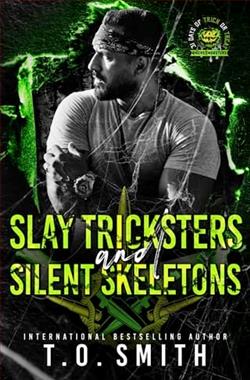Page 10 of Lord of Darkness (Maiden Lane 5)
When she didn’t finish the sentence, Sarah moved restlessly. “See what?”
Where Roger was murdered. Even the thought sent a shard of dull pain through her heart. She’d directed Tom the coachman to drive into St. Giles, hoping to find some lingering trace of Roger. There hadn’t been, of course. He’d been long dead. Long lost to her. But she’d had a second reason to look around St. Giles: to learn more about Roger’s murderer, the Ghost of St. Giles. And in that, at least, she’d succeeded. The Ghost had appeared. She hadn’t been adequately prepared tonight, but next time she would be.
Next time she wouldn’t let him get away.
Next time she’d blast a bullet through the Ghost of St. Giles’s black heart.
“Megs?” Her friend’s gentle murmur interrupted her bloody thoughts.
Megs shook her head and smiled brightly—perhaps too brightly—at her dear friend. “Never mind.”
“What—”
“Goodness, are we here already?” Megs’s change of subject was not subtle, but the carriage was slowing as if they’d finally arrived at their destination.
She leaned forward, peering out the window. The street was dark.
Megs frowned. “Maybe not.”
Sarah crossed her arms. “What do you see?”
“We’re on a narrow, winding lane and there’s a tall, dark house up ahead. It looks very … um …”
“Ancient?”
Megs glanced at her companion. “Yes?”
Sarah nodded once. “That’s Saint House, then. It’s as old as dust, didn’t you know? Didn’t you see Saint House when you married my brother?”
“No.” Megs pretended to be engrossed in the dim view out the window. “The wedding breakfast was at my brother’s house and I left London a sennight after.” And in between she’d been bedridden at her mother’s house. Megs pushed the sad memory from her mind. “How old is Saint House?”
“Medieval and, as I remember, quite drafty in winter.”
“Oh.”
“And not in the most fashionable part of London, either,” Sarah continued cheerfully. “Right on the riverbank. But that’s what you get when your family came over with the Conqueror: venerable old buildings without a lick of modern style or convenience.”
“I’m sure it’s quite famous,” Megs said, trying to be loyal. She was a St. John now after all.
“Oh, yes,” Sarah said, her tone dry. “Saint House has been mentioned in more than one history. No doubt that’ll comfort you when your toes turn to blocks of ice in the middle of the night.”
“If it’s so awful, then why did you accompany me to London?” Megs asked.
“To see the sights and shop, of course.” Sarah sounded quite cheerful despite her gloomy description of Saint House. “It’s been forever since I was last in London.”
The carriage jerked to a halt at that moment, and Sarah began gathering her needlework basket and shawls. Oliver, the younger of the two footmen Megs had brought with them, opened the door to the carriage. He wore a white wig as part of his livery, but it didn’t disguise his red eyebrows.
“Never thought we’d make it alive,” Oliver muttered as he set the steps. “Was a close one with them footpads, if’n you don’t mind me saying so, m’lady.”
“You and Johnny were very brave,” Megs said as she stepped down. She glanced up at her coachman. “And you, too, Tom.”
The coachman grunted and hunched his broad shoulders. “Ye an’ Miss St. John best be gettin’ inside, m’lady, where ’tis safe.”
“I will.” Megs turned to the house and only then noticed the second carriage, already drawn up outside.
Sarah stepped down beside her. “It looks like your great-aunt Elvina arrived before us.”
“Yes, it does,” Megs said slowly. “But why is her carriage still outside?”















